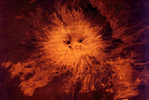
 Venus
Venus

Planet Profile
Mass ............................................. 4.87 X 1024 kg Diameter ...............................................12,104 km Mean density ............................................ 5.25 gm/cm3 Escape velocity ........................................10,400 m/s Average distance from Sun (AU).......................... 0.723 Rotation period (length of day in Earth days)........... 243.0 Revolution period (length of year in Earth days)........ 224.7 Obliquity (tilt of axis).................................. 178° Orbit inclination ....................................... 3.39° Orbit eccentricity (deviation from circular)............ 0.007 Mean surface temperature ................................. 726 °K Visual geometric albedo (reflectivity)................... 0.59 Highest point on surface....................... Maxwell Montes (17 km above planetary radius) Atmospheric components..................... 96% carbon dioxide 3% nitrogen 0.1% water vapor Surface materials......... basaltic rock and altered materials

 Venus in Color
Venus in ColorThe bluish hue of Venus is an effect of the colorization technique used to enhance subtle contrasts in cloud patterns and indicates that this image was taken through a violet filter. Features in the sulfuric acid clouds near the top of the planet's atmosphere are most prominent in violet and ultraviolet light. This image shows the east to west cloud banding and the brighter polar hoods . The features are embedded in winds that flow from east to west at about 370 kph (230 mph).
 Twin Summit (Click image to enlarge view)
Twin Summit (Click image to enlarge view)Located in the Atla Regio region of Venus is Sapas Mons. The sides of the volcano are covered with numerous overlapping lava flows, many of which appear to have originated along the sides of the volcano rather than from its double summit. This type of eruption is common of large shield volcanos on Earth, such as those found in Hawaii. Color was artificially added to this image and is based on the colors that the Soviet Venera 13 and 14 spacecraft observed in the 1970s.
